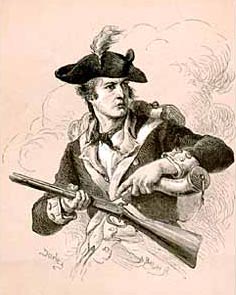 |
The American Revolution was fought between Britain and thirteen of its North American colonies. Most historians maintain that the war began on April 19, 1775, with the battles of Lexington and Concord in Massachusetts, although the colonies did not officially approve and issue a Declaration of Independence until July 4, 1776. The colonists rebelled for two principal reasons. The first was taxation that Britain imposed to help it pay off its debts from the French and Indian War. The second reason involved Britain's refusal to allow its colonists to settle the Ohio Country. Britain, hoping to prevent further conflicts with American Indians (such as Pontiac's Rebellion) had issued the Proclamation of 1763. It prohibited white settlement of the Ohio Country.
The American Revolution lasted until 1783, although the final major battle between the British Army and the Continental Army took place at Yorktown, Virginia, in October 1781. The Treaty of Paris (1783) formally ended the war. Under this treaty, Britain recognized America's independence. The British relinquished all land north of Florida, south of Canada, and east of the Mississippi River to the Americans and promised to remove all of its soldiers from this territory. Few major battles occurred in the Ohio Country during the American Revolution. There was, however, tremendous bloodshed as the Americans and the British struggled to gain the support of the region's American Indian inhabitants. Many American Indian nations, such as the Shawnee and the Delaware, initially hoped to remain neutral in the conflict. Most eventually sided with Britain. They feared that, if the Americans emerged victorious, white settlers would flood into the Ohio Country.
English soldiers under various commanders, including Henry Bird and Henry Hamilton, conducted raids with their American Indian allies against American outposts, such as Fort Laurens, in the Ohio Country. U.S. military commanders, such as Archibold Lochry, George Rogers Clark, Daniel Brodhead, David Williamson, Edward Hand, and William Crawford, also attacked the British and their American Indian allies. On several occasions, the U.S. military destroyed settlements and murdered American Indian captives. The most brutal example of this was the Gnadenhutten Massacre in 1782. Once the war ended in 1783, tensions continued to remain high between the United States and the region's American Indians. Violence continued as settlers moved into the territory won from the British in the American Revolution.
See Also
- Henry Bird
- Daniel Brodhead
- William Crawford
- Edward Hand
- Henry Hamilton
- Pontiac
- French and Indian War
- Gnadenhutten Massacre
- Delaware Indians
- Shawnee Indians
- Pontiac's Rebellion
- Ohio Country
- Archibald Lochry
- George R. Clark
- David Williamson
- Declaration of Independence
- Proclamation of 1763
- Treaty of Paris (1783)
- Ottawa Indians
- Wyandot Indians
- Fort Duquesne
- Bouquet's Expedition
- Proclamation of 1763
- Gnadenhutten
References
- Hurt, R. Douglas. The Ohio Frontier: Crucible of the Old Northwest, 1720-1830. Bloomington, IN: Indiana University Press, 1996.